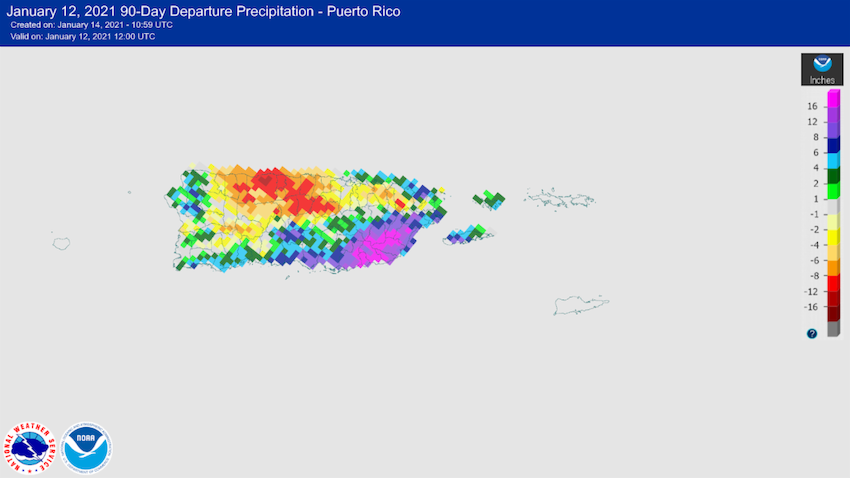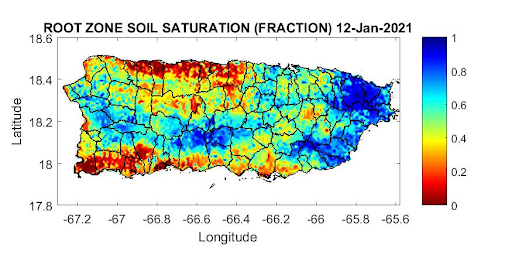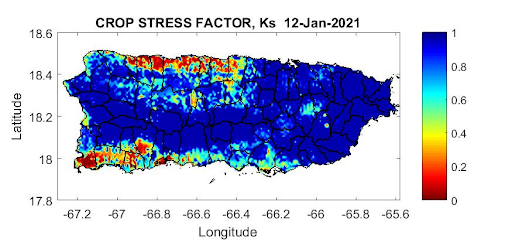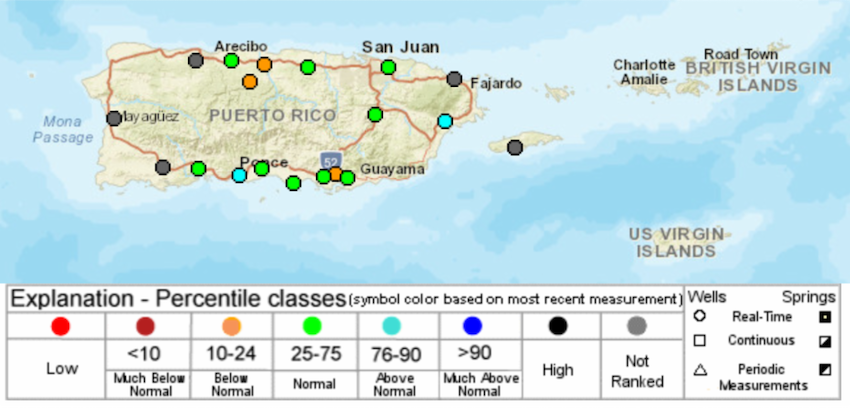Abnormally dry to moderate drought conditions are observed across north central Puerto Rico and the central northern coast as well as all of the U.S. Virgin Islands. Some deterioration in the drought conditions is possible during the next few months.
Key Points
- Puerto Rico Conditions: Abnormal dryness and drought are currently observed across 22% of the area, with about 5% classified in moderate drought.
- U.S. Virgin Islands Conditions: Abnormal dryness is currently observed in Saint Croix, Saint John, and Saint Thomas.
- Impacts: No major impacts are reported at this time. Nevertheless, the fire danger weather in Puerto Rico may increase as dryness intensifies. Preparations of irrigation and water efficiency tools are being made to better manage water during the dry season.
- Looking Ahead: The dry season usually continues through March with the onset of the wet season in late April. Therefore, a deterioration in drought conditions is possible.
- For weather information specific to your area, please monitor products issued by the National Weather Service in San Juan, Puerto Rico.
The U.S. Drought Monitor (USDM) is updated each Thursday to show the location and intensity of drought across the country. Drought categories show experts’ assessments of conditions related to dryness and drought including observations of how much water is available in streams, lakes, and soils compared to usual for the same time of year. Learn more.
Across Puerto Rico, Abnormally Dry (D0) conditions are observed across 22% of the island, with about 5% classified in Moderate Drought (D1).
The U.S. Drought Monitor (USDM) is updated each Thursday to show the location and intensity of drought across the country. Drought categories show experts’ assessments of conditions related to dryness and drought including observations of how much water is available in streams, lakes, and soils compared to usual for the same time of year. Learn more.
Abnormally Dry (D0) conditions are observed across Saint Croix, Saint John, and Saint Thomas.
U.S. Drought Monitor Categories
U.S. Drought Monitor Categories
The U.S. Drought Monitor (USDM) is updated each Thursday to show the location and intensity of drought across the country. Drought categories show experts’ assessments of conditions related to dryness and drought including observations of how much water is available in streams, lakes, and soils compared to usual for the same time of year. Learn more.
Across Puerto Rico, Abnormally Dry (D0) conditions are observed across 22% of the island, with about 5% classified in Moderate Drought (D1).
The U.S. Drought Monitor (USDM) is updated each Thursday to show the location and intensity of drought across the country. Drought categories show experts’ assessments of conditions related to dryness and drought including observations of how much water is available in streams, lakes, and soils compared to usual for the same time of year. Learn more.
Abnormally Dry (D0) conditions are observed across Saint Croix, Saint John, and Saint Thomas.
Rainfall Deficits
- Puerto Rico: The 90-day rainfall deficits range from 8 to 12 inches across the interior and north central Puerto Rico. The southeast quadrant of the island remains wet.
- U.S. Virgin Islands: The 90-day rainfall deficits across the U.S. Virgin Islands range between 2 inches in St. Thomas to 5 inches at St. Croix.

Soil Moisture Conditions in Puerto Rico
- The latest soil moisture data in Puerto Rico from the Puerto Rico Agricultural Water Management (PRAGWATER) indicated the driest soils with the highest crop stress factor across north central and southwest Puerto Rico.


Reservoirs and Streamflow Conditions in Puerto Rico
- The 28-day average streamflow from the U.S. Geological Survey (USGS) river gauge network indicated most of the streamflows running at normal levels, except for a few outliers across north central Puerto Rico.

Groundwater Conditions
- The groundwater level retrieved from the U.S. Geological Survey (USGS) network indicated most of the wells across Puerto Rico and the U.S. Virgin Islands are at normal levels.

Outlooks and Impacts
Outlook
- Based on the 3-month extended forecast by the Caribbean Climate Outlook Forum (CariCOF), there is no predictability across the forecast area.
- Climatologically speaking, however, the dry season continues through March with the onset of the rainy season in late April.

Sector Impacts
Dairy and Livestock
- St. Thomas, USVI. Based on their experience from last year’s drought, livestock farmers are preparing for livestock water and hay storage in the event of an incoming drought. Farmers do not have any other access to water other than what they collect or have in wells for production.
- St. Croix, USVI. Ranchers are thinking about feed and looking at drought mitigation strategies to plan for vegetation distress, which impacts that and requires that they purchase hay. Farmers who have poultry, including both broilers and/or egg production, have smaller numbers of them overall since they must collect water in containers or use cistern water to provide for them.
Specialty and Row Crops
- Puerto Rico. Shallow-rooted crops in north central and southwestern municipalities without irrigation may be experiencing severe water stress.
- St. Thomas, USVI. Farmers are working to manage water usage plans but are limiting expansion plans, and some are moving to drought-tolerant crops to keep production up while still conserving water.
- St. John, USVI. Farmers are reporting that it appears they are moving to the dry season. While they also reported a strong growing season, roadside grass and vegetation are beginning to show easy signs of distress as of mid-December. Farmers are already actively running auto-irrigation systems, including drip systems to water crops. Since it is beginning to become dry, deer and insects are also beginning to migrate to irrigated crops. Most, at this time, are also focused on quick crops to keep production levels up. Farmers have access to an aquifer and wells on St. John.
Coffee
- Puerto Rico. Typically, the dry season beginning in January contributes to flowering. A low level of flowering was observed for the month of January, which is normal. This period also favors the spread of some pests, such as the leaf miner Leucoptera coffeella.
Plantains and Bananas
- Puerto Rico. Non-irrigated plantain and banana crops may be experiencing water stress in north central and southwestern municipalities.
Hay and Pasture
- Puerto Rico. Pastures are experiencing abnormally dry conditions in north central and southwestern municipalities.
Forest and Fire Conditions
- Region-wide. Forests have generally had adequate moisture throughout the winter, and fire danger is generally low. However, abnormally dry conditions and pockets of moderate drought in north central Puerto Rico and abnormally dry conditions on St. Croix, along with the advent of the dry season, may lead to increased fire danger in the coming months.

For More Information
- National Weather Service (NWS) Weather Forecast Office - San Juan: Climate and Drought Information
- NWS Drought Information Statements for Puerto Rico and the U.S. Caribbean
- Drought.gov:
- Caribbean Drought Bulletins. Caribbean Regional Climate Center, Caribbean Institute for Meteorology and Hydrology (CIMH), Barbados
- U.S. Department of Agriculture (USDA) Caribbean Climate Hub drought and disaster assistance resources for tropical forestry and agriculture
Prepared By
Odalys Martinez
Senior Service Hydrologist, NWS Weather Forecast Office San Juan
Meredith Muth
NOAA/National Integrated Drought Information System (NIDIS)
William Gould, Nora Alvarez, and Eva Holupchinski
USDA Caribbean Climate Hub, USFS International Institute of Tropical Forestry
Christina Chanes, Gregory Guannel
University of Virgin Islands
Victor Murphy
Climate Services Program Manager, National Weather Service Southern Region
Thanks to the Agricultural Extension Service, College of Agricultural Sciences, University of Puerto Rico-Mayaguez. Thanks to Salvador Baigés Ramírez, UPR Extension-Maricao, and Eric Harmsen, Professor of Agricultural Engineering UPR.
USVI Reporting Input: Several individuals contributed to this report and we are acknowledging the following for their support, including the faculty, staff and collaborators of the UVI School of Agriculture, UVI Physics Program, UVI Etelman Observatory, UVI Agricultural Experiment Station, VI Department of Agriculture, UVI Green Technology Center, as well as the USDA Office Chief Economist, National Parks Service in St. Croix, USDA Farm Service Agency, Coral Bay Community Council, and the many volunteer drought reporters and farmers from across the territory.
This Drought Update is issued in partnership between the National Integrated Drought Information System (NIDIS), National Oceanic and Atmospheric Administration (NOAA) National Weather Service, and the U.S. Department of Agriculture (USDA) and the University of the Virgin Islands. The purpose of the update is to communicate a potential area of concern for drought expansion and/or development within Puerto Rico and the U.S. Virgin Islands based on recent conditions and the upcoming three month forecast.
NIDIS and its partners will issue these updates every two months. Subscribe to receive these U.S. Caribbean drought updates via email here.





